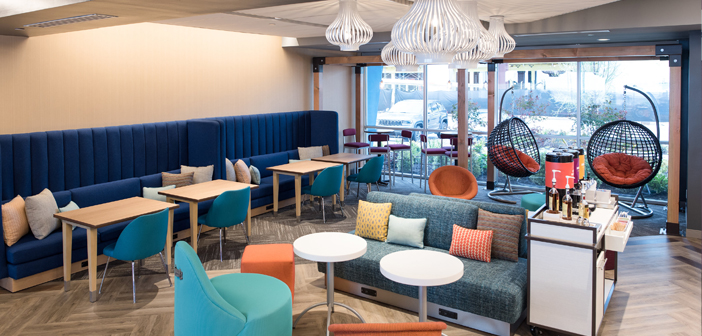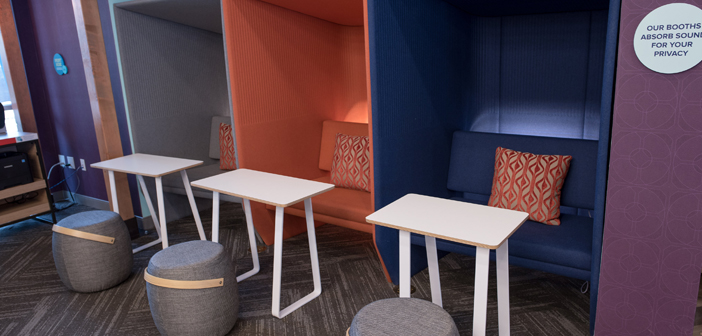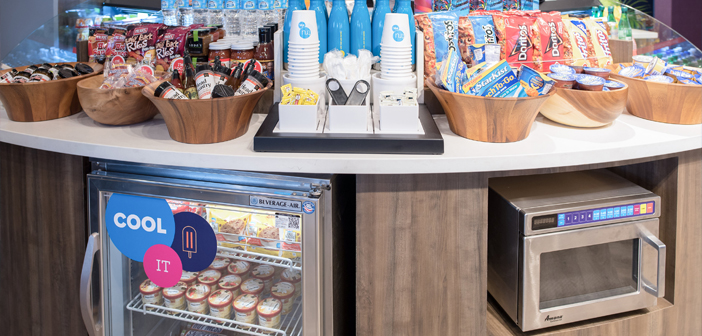How Hilton’s Tru brand created a new segment, and how AAHOA members helped along the way.
By Alicia Hoisington
When the Tru by Hilton brand first launched it was touted as a revolutionary new midscale brand and a disruptor in its space. As Tru continues to grow, global head of the brand Alexandra Jaritz, says those claims are proving true.

Champ Patel, CEO of Champion Hotels, an AAHOA member and owner of the first Tru hotel that opened on May 25 in Oklahoma City, was a big part of the process. He signed on to develop 16 Tru properties, and Jaritz calls him a “pioneer of the brand.”
When the brand launched in January 2016 it debuted with 102 signed deals in the United States. Most recently, the brand celebrated the grand opening on May 25 for the first Tru hotel, the Tru by Hilton Oklahoma City Airport, owned by AAHOA member Champ Patel. Another 10 to 15 Tru-branded hotels will also open this year in the U.S.
Now, with the fastest growing new development pipeline in industry history, a stat that is backed by hotel data company STR, the award-winning brand is set to continue its growth in the U.S. with plans to eventually move into Canada.
“Having the fastest growing pipeline in industry history is a huge disruptor,” Jaritz says. “It says a lot about the value that people see in it.”
A new take on midscale
Tru was conceived out of the need to fill a void in the midscale space, according to Jaritz. Hilton’s Hampton Inn and Suites brand had risen from the midscale segment to become a leader in the upper-midscale segment. With that rise came an opportunity for a new brand in a lower price point to woo the value-conscious customer.
“We saw that about 20 percent of our existing Hilton Honors members were, for certain trip occasions, choosing to stay at a brand outside of the Hilton portfolio because they were looking for more of a midscale, affordable brand,” Jaritz says. “We didn’t have that as part of our portfolio, and we wanted to recapture that share of business to keep our guests loyal and have an option for them at every price point.”
Hilton leaders looked at the existing supply in the midscale segment as well as guest feedback to determine what gap needed filled, Jaritz says. By examining that insight, they found guests craved a fresh product that was a consistent, modern new build that would give them more of an experience rather than the run-of-the-mill check-in and check-out process at hotels.
“We had an opportunity to develop from scratch a new-build brand with a great amount of consistency in the midscale segment to really have a competitive advantage versus a lot of the legacy products in the segment,” Jaritz says. “We wanted to make sure that we have a product available for people who just in general are looking for more of an affordable stay, forward-thinking technology, a design-forward brand, a brand with larger lobby space so they can connect with others.
“They were looking for something very different than what the midscale segment was offering today,” she says.
Leaders identified more than 20 million new consumers to target. While millennials are included in that group, the brand really strives to target those who are young at heart. These guests want to travel, but they don’t want to spend a lot of money. Regardless of age, they want to spend their money more on experiences rather than on a hotel.
“It became a compelling opportunity for us to enter, and we thought we’d have a competitive advantage to do very well – both from an owner proposition perspective and from a guest experience perspective,” Jaritz says.
Redefining spaces
To capture that new customer, and recapture the loyalty members staying outside the portfolio, the brand had to redefine the spaces traditionally known to the midscale segment. Therefore, Tru is built on three key pillars: simplified, spirited and grounded in value.
Those pillars are reflected in the brand’s overall design. First, the design is simplified. There are only two types of guestrooms: a 231-square-foot King room and a 285-square-foot Double room.
“The focus is on getting the guest what they need and not what they don’t need or don’t want to pay for,” Jaritz says. “It’s a matter of keeping things simple and intuitive from an operations and design standpoint.”
The conscious decision was made to make the guestrooms smaller than at other Hilton brands, but they are packed with a simplified and functional design. Rooms are furnished with platform beds leading to simplified operations and upkeep. There is no carpeting in rooms but rather luxury vinyl flooring, which shows off room cleanliness that carpet can often lack. Eight-foot windows bring in a lot of natural light, making rooms bright. Guestrooms also do not have enclosed closets or drawers because, through its research, Hilton found guests do not usually unpack their suitcases and maybe have one or two items they need to hang up. Thus, the brand got rid of a lot of large case goods in favor of a more open design.
Research also showed that guests prefer showers over bathtubs. Every guestroom, except for the ADA-compliant rooms, has a modern shower complete with high-end amenities that guests expect during their stay.
The brand’s technology mirrors the simplicity pillar, allowing for 100 percent digital check-in that enables guests to select their room type 24 hours in advance with the Hilton Honors app. Guests can also use digital keys on their phone, allowing them to bypass the front desk. In the room, guests will find 55-inch TVs, the largest standard of any Hilton brand, with DirecTv. Power outlets are everywhere in guestrooms and public space to accommodate today’s guest who travels with multiple devices. Wi-Fi speed is also the highest standard of all Hilton brands because forward-thinking technology is important to the mindset and spirit of the customers Tru seeks to attract.
The brand’s spirited pillar can also be seen throughout in both the guestrooms and public spaces, with design elements not typically seen in the midscale segment, according to Jaritz.
“We brought in design elements that were unexpected and creative, with pops of color and vibrancy but still comfortable,” she says. “There is quite a bit of color but it’s not overpowering, and it’s modern, comfortable and fresh.”
The brand was designed in the spirit of the customer it seeks to attract – those who are not necessarily part of a specific age group but rather who are young at heart, who might come from different generational cohorts but have similar mindsets. These guests tend to spend less time in their rooms and want to spend more time socializing with others in the lobby. Or, they prefer to be “socially alone” surrounded by others in a public space.
That’s why Tru’s guestrooms are smaller and the public space is magnified. The most distinguishing feature, Jaritz says, is the nearly 3,000-square-foot lobby at the center of the hotel. The lobby is filled to the brim with windows, letting in lots of natural light. Additionally, the lobby is comprised of different zones: work, longue, play/game and eat, for example.
In the play/game zone, stadium seating makes for a unique socialization area. In the new Oklahoma City property, pool tables round out the zone for entertainment. The eat zone is centered around the brand’s circular front desk that houses a unique marketplace which serves beer, wine, sparkling beverages, treats, snacks and localized souvenirs.
“The overall dynamic of the lobby is that there is a lot of activity,” Jaritz says. “You can also just sit in cocoon chairs and watch the world go by.”
A customized experience is also key to the brand’s spirit. Tru’s breakfast is unique in that is in top-it style, akin to popular frozen yogurt shops. Guests can choose from five or six different bases with 30 different toppings to create breakfast combinations customized just for them.
The 250-square-foot fitness center also allows for a more customized experience. Although the center still offers the typical cardio machines, it also includes unique elements such as a ballet bar. The fitness area also offers lots of space for flexibility, stretching and weight training.
“A lot of what we have been trying to do is help give guests, which we saw with the research, the ability to customize their own experience in the price point that we have,” Jaritz says.
The spirit of the local community can also be seen in the brand. Each hotel will feature life-sized, custom mural artwork unique to each location. But the Tru spirit is not only seen in the hotel design; team members embody it as well. Associates wear jeans with Tru shirts, topped off with buttons that tell guests a bit about employees’ personalities and who they are.
“We have a brand hospitality culture called Tru Spirit,” Jaritz says. “We are one Tru team full of life, and we really want to see our team members delivering an experience where they are going to be lovable, imaginative, flexible and energetic.”
With team members delivering this type of experience, Jaritz says it helps to create the spirit of a Tru vibe.
“We believe we created a new category,” she says. “Who are the competitors? If you look and walk through what’s out there, there is no brand at this price point that offers this setup.”
Finally, Tru is grounded in value. In order to make the brand more affordable, leaders had to make decisions about what could be cut from the traditional hotel stay without upsetting a great guest experience. For example, they found guests can do without in-room coffee. Instead, premium Italian coffee is available 24/7 in the lobby.
“We made tradeoff decisions, where we said we can only afford to build this hotel at a certain cost to generate a certain return for our owners,” she says. “We had to make a lot of tradeoff decisions to be able to deliver a product that guests would feel they were still getting a great experience. We couldn’t give them everything; otherwise, we wouldn’t be grounded in value.”
All told, Jaritz says the brand is about redefining a segment to pave the way for the future.
“We really tried to create a new segment, and it’s now changing years’ worth of guest expectations of what this scale was defined like in the past and educating them of what it can be in the future,” she says.
A valuable development
Grounded in value isn’t just about guest wants and needs. Owners were very much a part of the equation.
“We really wanted to design something that could be built on smaller land sizes,” Jaritz says. That’s why the prototype is a four-story, 98-key property.
With the result of not needing so much land to build, Hilton has seen growth for Tru in a variety of different market types. Jaritz says there has been interest and resultant franchise agreements in college towns, airport locations, resort locations and downtown urban areas.
“They really cross the gamut, and I think it’s really as a result of the very compact and efficient prototype and the land costs and smaller land requirement,” she says.
About 10 percent of the pipeline for Tru is part of a dual-branded property, according to Jaritz. The combination she says seems to be the most popular is Tru and Home2 Suites.
Total investment costs are another reason Jaritz says developers are interested in the product. Another key piece of strategy for Hilton was to ensure investment costs would be between 15 and 20 percent lower than Hampton.
“That’s quite a sizable difference, and that’s another reason why this is a great investment opportunity because it is easier to get financing and because the initial outlay for land and for total construction costs is lower,” she says.
For owners looking for a turnkey solution to get a brand developed, opened and ready for returns, Jaritz says Tru is perfect.
“We’re focused on developing a product that is simplified, simple to build, operate and maintain,” she says. “There is also a lot of support to help owners who may have not worked with Hilton before.” ■
Partnering with AAHOA
Hilton’s Tru brand was developed and value-engineered side-by-side with AAHOA members. The brand first started development with a dozen midscale advisory group members, all longstanding Hampton or Home2 Suites owners and many of them AAHOA members, according to Alexandra Jaritz, global head of the Tru by Hilton brand.
“It’s always great to be plugged into the AAHOA network because we learn as much from them with their feedback and their partnership as they do from us,” Jaritz says. “The goal is ultimately for both of us to be successful, and that partnership for Tru continues to be phenomenal.”
Champ Patel, CEO of Champion Hotels, an AAHOA member and owner of the first Tru hotel that opened on May 25 in Oklahoma City, was a big part of the process. He signed on to develop 16 Tru properties, and Jaritz calls him a “pioneer of the brand.”
“It’s never easy being the first at anything, let alone a brand that is disruptive and changing guest expectations,” she says. “Being the first, you learn things along the way. The partnership we developed with Champ and his team… it’s been a blessing and a gift to work with him.”
Jaritz says the Tru brand wouldn’t be as far as it is today without the advisory group members and the AAHOA members that comprise it, adding that the feedback and sharing of experiences have helped make it such a success.
“We shared with them about the things we were thinking through and asked them to tap into the AAHOA network and give us feedback from the community,” she says. “Having that constant feedback has been phenomenal.”

















